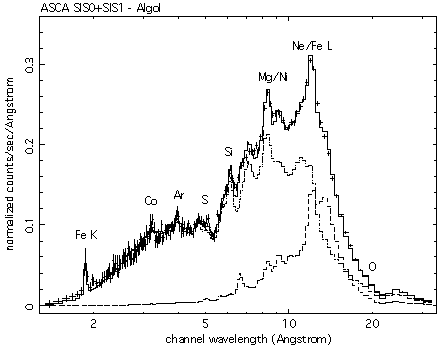|
|

On the cover
The ASCA archive opened in November 1994, and already has become one of the most popular of the HEASARC data sets. The front cover picture shows one of the data sets now available in the public domain, the SIS spectrum of Algol. This coronal X-ray source is rich in emission lines which can be used to determine the temperature distribution and abundance of the emitting plasma. The data (crosses) have been fit to a plasma model (solid histogram) that contains two temperatures of 7.8 and 27 million degrees. The various detected line complexes are indicated. These lines are weaker than expected, which suggests the abundances of iron, oxygen, sulphur, silicon, argon and calcium are one third to one half the solar photospheric value. See the papers Antunes et al (1994) Ap J Letters 436, L83 and Singh et al (1995) Ap J 445, 840 for further details.
 Proceed to the next article
Proceed to the next article
 Return to the previous article
Return to the previous article
HEASARC Home | Observatories | Archive | Calibration | Software | Tools | Students/Teachers/Public Last modified: Monday, 19-Jun-2006 11:40:52 EDT HEASARC Staff Scientist Position - Applications are now being accepted for a Staff Scientist with significant experience and interest in the technical aspects of astrophysics research, to work in the High Energy Astrophysics Science Archive Research Center (HEASARC) at NASA Goddard Space Flight Center (GSFC) in Greenbelt, MD. Refer to the AAS Job register for full details. |


 Select another article
Select another article